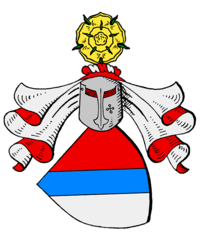Osterhausen (noble family)
Osterhausen is the name of an old Saxon - Thuringian noble family with the parent house of the same name Osterhausen in the Sittichenbach office , which later also came into possession and reputation in Hesse and Prussia .
history
The family first appeared in a document in 1200 with Albert von Osterhausen and began its uninterrupted line of tribe with Melchior von Osterhausen (documented 1491–1503) on Gatterstädt near Querfurt. Thilo, son of Melchior and Helene von Reblingen, had a son, Hans (I.), Barbara von Halsberg. The sons of Hans (I.) and Anna Barbara von Kayn (en) were Hans Georg, cavalry master of the Electorate of Saxony, captain on the Rudelsburg and official castles of Freyburg , Eckartsberga and Weißenfels and Hans (II.), Colonel of the Electorate of Saxony on horseback. Hans Georg von Osterhausen owned the Rudelsburg, Crölpa , Freiroda , Kreipitzsch and Gatterstädt in 1581 , which he had acquired from the von Bünau auf Teuchern family. In 1598 Hans Georg also acquired the knight's seat in Gleina and the fiefdom, which was made up of four settlements.
In 1605, Bastian von Osterhausen, Herr auf Rudelsburg, Kreipitzsch and Gatterstädt, received the legal domicile in Gleina from Elector Christian II. He was the first court instance under the highest sovereign, and he now also had jurisdiction over the Gleina subjects in the village and the corridor. In 1621 the von Osterhausen family were also feudal lords of the village of Steigra . In 1671 the family sold the Rudelsburg, together with Kreipitzsch and the Saalecksburg, to the von Kreutzen family .
Around 1683, Georg Sebastian's grandson Georg Heinrich von Osterhausen, a royal Saxon, high-ranking chamberlain and chief forest and game master, sold the Gleina estate, including the knight's seat, the legal status and the legal powers to Johann Adolph von Marschall .
The family was wealthy in Saxony and Thuringia in Böhlen , Gatterstädt , Gleina , Ilmnitz , Kreipitzsch , Lockwitz , Moderwitz , Nickern , Oldenrode , Poderschau , Reinhardtsgrimma , Rüben , Rudelsburg , Steinau , Wagau , among others .
Admission to the Knighthood of the Old Hessen on May 16, 1830 for the brothers Carl, Electoral Hessian Chamberlain and Court Marshal, and Friedrich von Osterhausen, Electoral Hessian Chief Forester.
coat of arms
The coat of arms is divided by a blue diagonal bar of red and silver. On the helmet with red and silver covers a golden rose with green sepals.
Instead of a blue one, an ash-colored (Siebmacher) or black or gold bar is also possible. There is also a red coat of arms that is divided by a silver sloping bar. The helmet can be crowned with silver bulges instead of red and the rose can be red instead of gold.
Personalities
-
Hans George von Osterhausen († 1603), electoral Saxon captain of the offices of Weißenfels, Freyburg and Eckartsberga, owner of the manors Gatterstädt, Gleina and Rudelsburg
-
Georg Sebastian von Osterhausen (1575–1650), son of the above, owner of the manor
- Hans Georg von Osterhausen (* 1603; †?), Son of the above, court official and chef in Schleswig-Holstein services
- Johann Georg von Osterhausen († 1627), Saxon Electoral Court Marshal
- Melchior von Osterhausen († 1614)
- Johann Siegmund von Osterhausen († 1679), Provost of the Naumburg Monastery, Princely Saxon Council, court judge at the court in Jena, inspector of the Pforta state school, court lord and liege lord of the city of Osterfeld
-
Georg Sebastian von Osterhausen (1575–1650), son of the above, owner of the manor
- Christian von Osterhausen (* before 1644, † after 1660), court marshal of the Electorate of Saxony and grand prior of the Order of Malta and author of specialist publications on this
Were members of the Fruitful Society
- Hans Georg von Osterhausen, son of Melchior von Osterhausen auf Gatterstädt - "the one in love"
- Hans Thilo von Osterhausen - "the one who drives"
See also
literature
- Leopold von Ledebur : Adelslexicon of the Prussian Monarchy , Volume 2, Berlin 1856, p. 173
- Ernst Heinrich Kneschke (ed.): New general German nobility lexicon , Volume 7, Leipzig 1867, pp. 9-10
- Leopold Nedopil: German nobility samples from the German Ordens-Central-Archive ; 1868
- Deutsche Adelsgenossenschaft (Ed.): Yearbook of the German Adels , Volume 2, 1898, published by WT Bruer, pp. 761–765
- Genealogisches Handbuch des Adels , Adelslexikon Volume X, Volume 119 of the complete series, pp. 79-80, CA Starke Verlag, Limburg (Lahn) 1999, ISSN 0435-2408
Individual evidence
- ↑ Otto Posse (Ed.): Codex diplom. Saxoniae regiae , main part 1, volume 3; Leipzig 1898, No. 30

